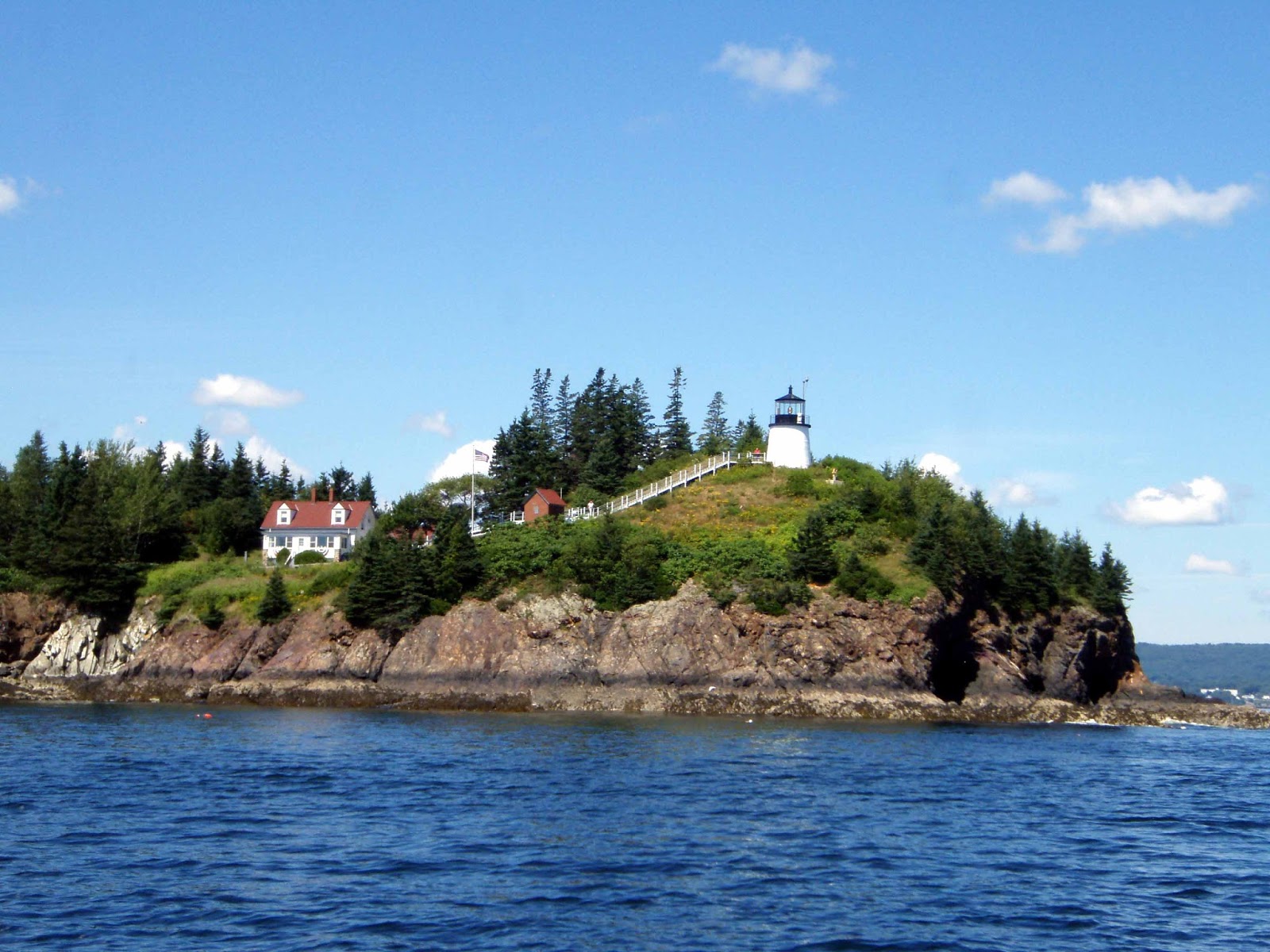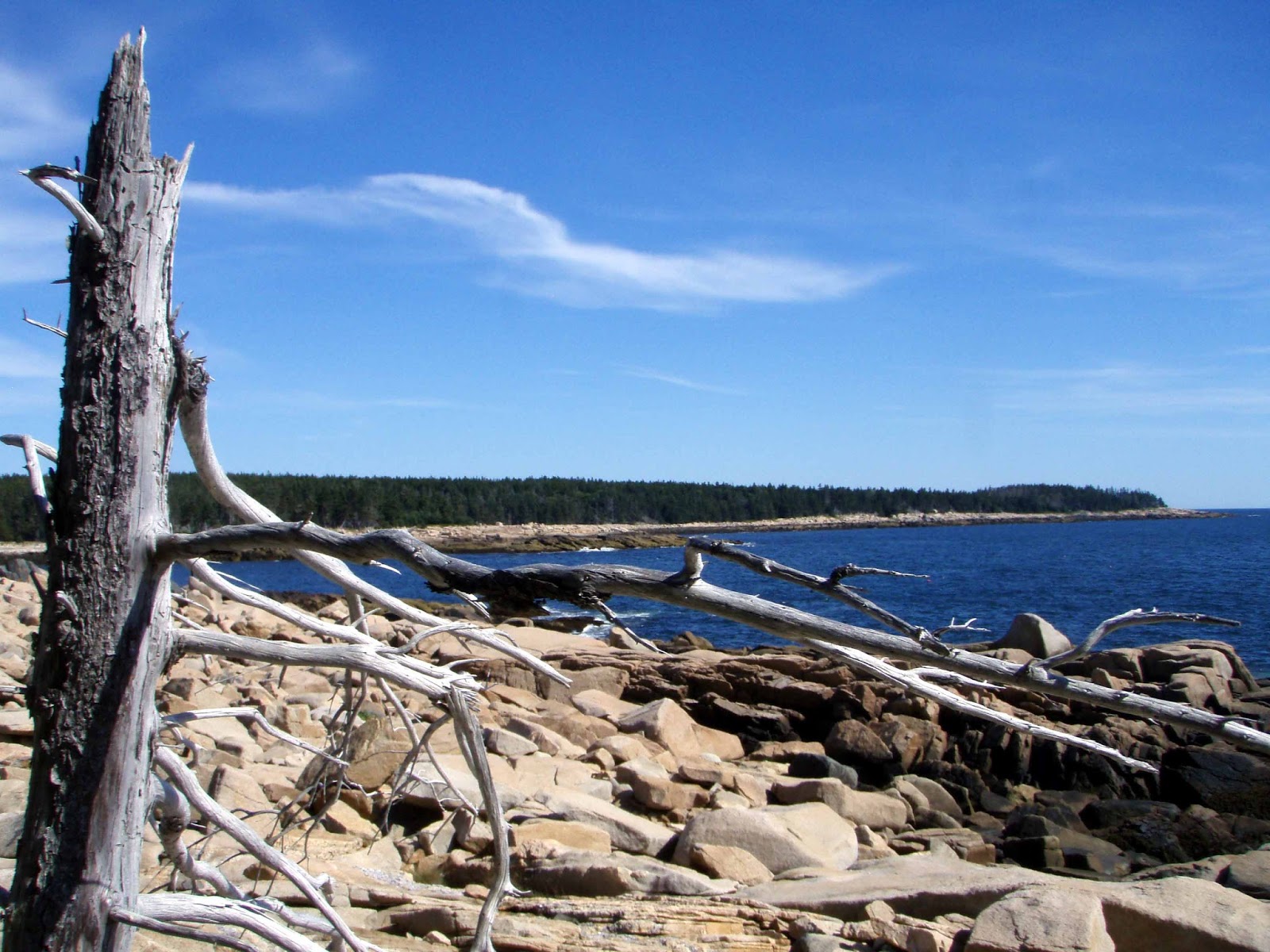We’ve been in Maine
for almost a month, but we start to sense a change of seasons. Dry leaves begin to scatter on the ground,
and a few of the trees are showing a little color. Fall comes early to Downeast Maine, and we are
getting the message that it is time to head southwest.
We are not rushing though, but rather taking time to hop
through the islands, visiting harbors that are new to us. First stop is Buckle
Harbor on Swan Island. It is remote and difficult to enter, but we
are rewarded with a protected anchorage with only a few other boats and
glorious views back to the mountains of Acadia.
 |
| The view from Buckle Harbor - we're not that far from Acadia at this point |
The next day takes us through the Deer Island Thoroughfare
to an anchorage amongst the small islands of Merchant Row.
 |
| One of the Camden schooners plies the waters of the Thoroughfare - look closely at all the d___ lobster pots |
We tuck in between Camp
Island and the colorfully named Devil’s Island and Hell’s Half Acre. Come low tide a
multitude of rocky islets and ledges appear – after all we are in the land of
ten foot tides. We delight in climbing
around this pink granite playground. The area is known for its granite quarries
which have supplied the building materials for many famous buildings and
bridges in Boston and New York City.
 |
| A vista over the Camp Island anchorage |
 |
| Burt tests his strength on the rocky shore at Camp Island |
About a mile away by dinghy is
the town of Stonington.
This is an interesting place if you are intrigued by lobsters. Stonington has
the distinction of supplying more lobsters to market than any other port in Maine. Three large piers dominate the waterfront
with trucks and cranes carting away the day’s catch. While located on the south
side of Deer Island, there is a bridge connecting the
north side of the island to the mainland, thus allowing easy transportation of
the catch to the northeast and world markets. And if there is any question
about priorities, lobster boats get the moorings closest to town, other
commercial boats come next, and pleasure boats are at the far extremes.
 |
| Stonington's working waterfront |
 |
| Looking back at Stonington at low tide |
The place rings with authenticity, and it is
here that Burt purchases a very interesting book on the anthropology and
sociology of the lobstering industry.
 |
| Looking down one of the side streets in Stonington |
Our next hop takes us to an anchorage near North
Haven on an island of the same name. In contrast to Stonington,
North Haven’s heritage evolves from summer
residents.
 |
| An interesting house at North Haven that is said to emulate a ship |
There are few lobster boats
in the harbor, but rather a sizable fleet of historic wooden racing dinghies.
We stroll through the town and dinghy along the waterfront.
 |
| North Haven's not so working waterfront |
Back at our anchorage, a creek meanders off
the bay. It is a protected hurricane
hole with a number of local boats moored inside along with a very stylish
houseboat. The entire shoreline is unoccupied conservancy land.
 |
| A well maintained houseboat in an idyllic anchorage |
Enough poking around – we head back to Camden for a day of
laundry and grocery shopping utilizing the marina’s courtesy car, a luxury that
I could easily become accustomed to. The next day we position ourselves at Tenants Harbor
for the following day’s 24 hour passage to Provincetown. The entrance to the harbor is
guarded by the extensive compound belonging to Jamie Wyeth.
 |
| Jamie Wyeth's island at the entrance to Tenants Harbor - he has restored the historical lighthouse on the island |
The surrounding barren
topography is indicative of the settings of so many of Jamie’s and Andrew’s
paintings. Tenants
Harbor is a bit of a
backwater lobstering village. There isn’t much here except lobster boats and a fisheries
cooperative dock. But, we have come to meet up with Polly and Denny Davis,
friends from Mansfield,
who have been coming here to their cottage for over forty years. They join us for Happy Hour on our boat,
experiencing perhaps a different perspective on immersing oneself in coastal Maine.
The next morning, we spend several hours passing through the
last of the lobster pots, probably the only thing we won’t miss about Maine. There is no wind,
as has been the case for the entire month, and we motor over glassy seas with
an almost full moon during the night. After midnight wind does begin to materialize,
and by the time we have reached the protection of Cape Cod
we are seeing gusts up to 20 knots. With flat seas and full sails we have a
glorious hour or so of sailing before screaming into Provincetown Harbor.
It does not take long until we are contacted by cruising friends Jim and
Bently. They have spent the summer in Provincetown
and will be playing guitar and banjo in town that afternoon. We meet up with them and enjoy their talented
renditions of traditional maritime songs.
 |
| Bently and Jim entertain us on the streets of Provincetown - we enjoy their music at many locations during the year. |
As usual, Provincetown is crowded with tourists, but we
leave the congestion to bike out to the Cape Cod National Seashore.
 |
| Just try to ride you bike (or drive a car) through these streets |
An asphalt bike path winds for miles through
the steep dunes to the beach at Race Point.
It is a challenging ride for someone with knee problems, but I make it
and we celebrate with a picnic lunch on the beach. The next day we head off on the same ride but
I opt to stop short of the hilly part for coffee at the new park concession
while Burt knocks himself out again.
 |
| Bicycling through the dunes with the shore and restored historic lifesaving station in the distance |
It is about another seventy miles to Newport, and we do the trek
in two days as currents in the Cape Cod Canal dictate the schedule. After a late afternoon transit of the canal
we anchor in Nasketucket Bay off the western shore
of Buzzards Bay, and the next morning
in dense fog, pick our way towards Newport. It is especially harrowing to weave through
the traffic of Narragansett Bay. At one point, with probably only 200 feet of
visibility we find ourselves in the milling crowd of a fleet of Farr 40’s,
awaiting better visibility and the start to their races for the World
Championship. That was a close one! The fog lightens as we enter the harbor and
anchor right off Fort
Adams. But, later that afternoon after taking the
dinghy into town, we return to the boat again in thick fog. Where’s that GPS
when we need it?!?
 |
| A large fleet of Shields sloops race right off our anchorage |


































